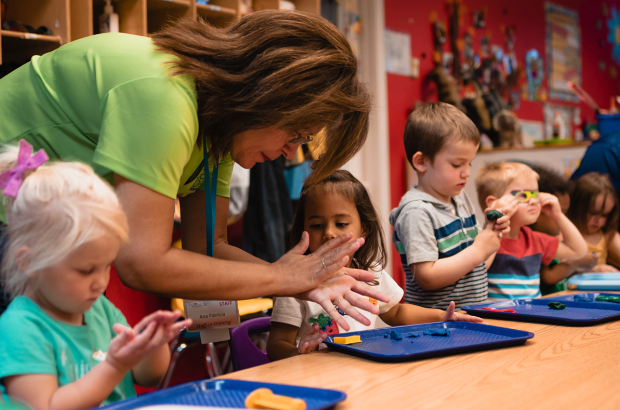-1.png)
Kindergarten is often referred to as the gateway to formal education, where children take their first steps into structured learning environments. It plays a crucial role in a child’s overall development by providing a nurturing setting that fosters cognitive, social, and emotional growth.
What Is Kindergarten Education?
Kindergarten education refers to the early childhood educational program designed for children typically aged 4 to 6 years. It serves as a bridge between home or preschool and formal schooling. The focus is on creating a balanced approach that combines play, exploration, and structured activities to encourage holistic development.
Key Goals of Kindergarten Education
- Cognitive Development
- Introduce foundational concepts in literacy and numeracy.
- Foster curiosity through hands-on activities and experiments.
- Enhance problem-solving and critical thinking skills.
- Social and Emotional Growth
- Encourage teamwork and collaboration.
- Develop empathy and respect for others.
- Help children learn to express and manage their emotions.
- Physical Development
- Promote fine motor skills through arts, crafts, and writing activities.
- Support gross motor skills with outdoor play and physical education.
- Creativity and Imagination
- Inspire creativity through storytelling, music, and art.
- Allow children to explore their ideas in a safe environment.
Curriculum in Kindergarten
The kindergarten curriculum typically combines academic learning with activities that nurture creativity and play. Here’s an overview of the main areas covered:
1. Literacy
- Learning the alphabet, sounds, and basic word formation.
- Developing listening and speaking skills through storytelling and conversations.
- Introducing reading readiness with simple books and visual aids.
2. Numeracy
- Recognizing numbers, counting, and basic arithmetic.
- Understanding shapes, patterns, and spatial awareness.
- Incorporating math concepts into everyday activities.
3. Science and Nature
- Encouraging curiosity about the natural world.
- Simple experiments to understand basic scientific principles.
- Lessons about animals, plants, weather, and the environment.
4. Social Studies
- Understanding community roles and responsibilities.
- Learning about different cultures and traditions.
- Developing a sense of identity and belonging.
5. Arts and Crafts
- Exploring creativity with drawing, painting, and crafting.
- Developing fine motor skills through hands-on projects.
- Expressing emotions and ideas visually.
The Importance of Play in Kindergarten
Play is a cornerstone of kindergarten education. It supports learning by:
- Enhancing Creativity: Free play allows children to express themselves in imaginative ways.
- Encouraging Social Interaction: Group play activities teach cooperation and communication.
- Improving Problem-Solving: Structured games and puzzles help develop cognitive skills.
Benefits of Kindergarten Education
- School Readiness
- Prepares children for the structured environment of primary school.
- Helps them adjust to routines and expectations.
- Social Skills Development
- Provides opportunities to interact with peers.
- Teaches sharing, taking turns, and resolving conflicts.
- Building Confidence
- Encourages independence and self-expression.
- Boosts self-esteem through accomplishments and praise.
- Parental Involvement
- Kindergarten often involves parents in activities, strengthening the home-school connection.
Challenges in Kindergarten Education
- Transition Anxiety
- Some children may face separation anxiety when starting school.
- Teachers and parents can help ease this by creating a supportive environment.
- Balancing Play and Learning
- Striking the right balance between free play and structured learning can be challenging.
- Individual Differences
- Children develop at different rates, requiring personalized attention to meet diverse needs.
Role of Teachers in Kindergarten
Kindergarten teachers are more than educators; they are mentors, guides, and caretakers. Their responsibilities include:
- Creating a welcoming and safe classroom environment.
- Planning engaging lessons tailored to young learners.
- Observing and assessing each child’s progress.
- Communicating regularly with parents to ensure continuity in learning.
The Future of Kindergarten Education
As technology and educational methods evolve, so does kindergarten education. Trends include:
- Digital Integration: Interactive learning tools and apps enhance traditional teaching methods.
- Focus on STEAM: Introducing science, technology, engineering, arts, and mathematics at an early age.
- Personalized Learning: Adapting lessons to suit individual learning styles and paces.
Conclusion
Kindergarten is more than just an introduction to school—it’s a vital phase where children build the foundation for lifelong learning. Through a blend of academics, play, and social interaction, kindergarten helps shape well-rounded individuals ready to navigate the challenges of formal education and beyond. By recognizing its importance and continually improving teaching methods, we can ensure that every child has a bright and promising start to their educational journey.



